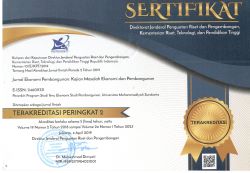Novel Innovation of Subsidized Fertilizers based on Soil Variability and Farmer’s Perception
Elisa Wildayana(1*), M. Edi Armanto(2), Imron Zahri(3), M. Yamin Hasan(4)(1) Faculty of Agriculture, Sriwijaya University
(2) Faculty of Agriculture, Sriwijaya University
(3) Faculty of Agriculture, Sriwijaya University
(4) Faculty of Agriculture, Sriwijaya University
(*) Corresponding Author
Abstract
The study aimed to find novel innovation and research of subsidized fertilizers based on soil nutrient variability and farmer’s perception in rice farming. This study uses a completely randomized design with four natural treatments, a one-way Anova and Tukey HSD Test as well as multiple linear and cubic regressions. The fertilizer uniformity on varied ricefields was a big failure because it causes fertilization becoming ineffective, inefficient and unsustainable. Ricefield variability (due to geomorphogenesis, pedogenesis, interflow flow, vegetation distribution, land use patterns, and fertilizer application) causes not optimized fertilization (dose, balance, time, methods of fertilization). The perception of farmers can create conflicts of interest, which are determined as normal, unavoidable and natural. Short-term research target is how fertilization in the field is done effectively, efficiently, and sustainably, whereas long-term target is to generate new sources of wealth, fertilization technology based on soil science knowledge, forming professional researcher, the great inventions of patents, cooperation media between scientists, technocrats and bureaucrats and research funding.
Keywords
Full Text:
PDFReferences
Armanto, M.E. and M.A. Adzemi. 2013. Maps of Thought and Scientific Papers. Bulletin Agroteks, FASM UMT Malaysia Bil 4(2013): 4-7.
Armanto, M.E., M.A. Adzemi and E. . 2013. Understanding Characters of Compound Fertilizer and Its Alternative Uses. Bulletin Agroteks, FASM UMT Malaysia Bil 5(2013): 3-7.
Banful. A.B. 2011. Old Problems in the New Solutions? Politically Motivated Allocation of Program Benefits and the “New” Fertilizer Subsidies. World Development. Vol. 39(7); 1166-1176.
Druilhe, Z. and J. Barreiro-Hurlé. 2012. Fertilizer subsidies in sub-Saharan Africa. ESA Working paper No. 12-04. Rome, FAO.
Firmansyah, M.E. Armanto, R.H. Susanto, J. Arliansyah and M. Yazid. 2016. Community of Rural Road Network in Tanjung Lago District of Banyuasin South Sumatra. Asian Jr. of Microbiol. Biotech. Env. Sc. Vol. 18(1); 133-138
Hicks, D. 1999. Six reasons to do long-term research. Research Technology Management, July-August 1999, pp. 8-11.
Rachman, B. and T. Sudaryanto. 2010. Impacts and Future Perspectives of Fertilizer Policy in Indonesia. Analisis Kebijakan Pertanian. Vol. 8(3); 193-205.
Rashid. S., N. Tefera, N. Minot and G. Ayele. 2013. Can Modern Input Use be Promoted without Subsidies? An Analysis of Fertilizer in Ethiopia. Agricultural Economics. Vol. 44(6); 595-611.
Ricker-Gilbert, J., T.S. Jayne and J.R. Black. 2009. Does Subsidizing Fertilizer Increase Yields? Evidence from Malawi. Selected Paper prepared for presentation at the Agricultural & Applied Economics Association 2009 AAEA & ACCI Joint Annual Meeting, Milwaukee, Wisconsin, July 26-29, 2009
Rosenberg, N. 1990. Why do firms do basic research (with their own money)?. Research Policy, Vol. 19: 165-174.
Article Metrics
Abstract view(s): 755 time(s)PDF: 541 time(s)
Refbacks
- There are currently no refbacks.















